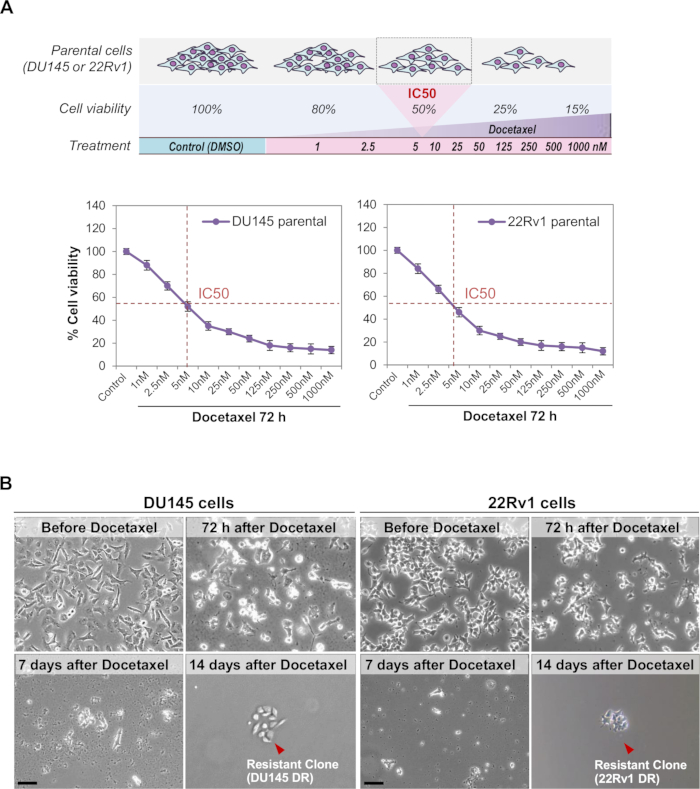Zum Anzeigen dieser Inhalte ist ein JoVE-Abonnement erforderlich. Melden Sie sich an oder starten Sie Ihre kostenlose Testversion.
Generating Chemoresistant Prostate Cancer Cells: A Procedure for Obtaining Drug-resistant Cancer Cells In Vitro
In diesem Artikel
Overview
This video describes a protocol for generating taxane-resistant cell models of prostate cancer. These models can help study the pathways involved in progression to Docetaxel resistance in prostate cancer patients.
Protokoll
1. Generation of Docetaxel-resistant Prostate Cancer Cells
NOTE: Perform cell treatments using Docetaxel solution stock used for the determination of IC50 drug concentration (prepare enough stock in advance for experimental use). Parental cells should be grown in parallel in a small flask throughout the whole procedure and exposed to vehicle (DMSO) in corresponding volumes mimicking the amounts used in the Docetaxel treated flasks.
- Plate DU145 or 22Rv1 cells in 150 cm2 flasks containing 20 mL of media (3.5 x 106 cells per flask for DU145 and 6.5 x 106 cells per flask for 22Rv1). Use of 10 to 20 flasks of cells is recommended to have enough cells at the end of the protocol.
- After 24 h, when cells are at about 70-80% confluence (Figure 1B, before Docetaxel), add Docetaxel at the IC50 concentration (5 nM for the cells described in this protocol).
- After 72 h, aspirate drug-containing media and add fresh, Docetaxel-free media (Figure 1B, 72 h after Docetaxel). Change the media every 3-4 days. Within approximately 1-2 weeks, resistant clones will appear evident under the microscope (Figure 1B, 7 and 14 days after Docetaxel).
- Aspirate media, carefully wash cells with 15 mL PBS and incubate with 4 mL 0.05% Trypsin-EDTA for 3-5 min at 37 °C to detach cells from the flask surface.
- Resuspend trypsinized cells from the flask using 8 mL of fresh media. Pool cells from all treated flasks. Pellet cells by centrifugation (300 x g, 3 min, RT).
- Remove the supernatant, resuspend the cell pellet in 20 mL of fresh media and plate the cells in 150 cm2 flasks (3.5 x 106 cells per flask for DU145 and 6.5 x 106 cells per flask for 22Rv1).
- After 24 h, when cells are at about 70-80% confluence, add 5 nM Docetaxel (initial IC50 concentration) again.
- Repeat steps 1.3 to 1.6 on day 3.
- After 24 h, when cells are at about 70-80% confluence, treat them with 2X IC50 Docetaxel concentration (10 nM for the cells described in this protocol).
- Repeat steps 1.3 to 1.8, following a dose-escalation of Docetaxel concentrations (25 nM, 50 nM, 100 nM, and 250 nM), to generate a stable population of cells growing in the flasks under the final highest concentration. For higher concentrations, the dose-escalation protocol can be implemented for up to 6 months until the 1,000 nM concentration is reached (Figure 2A).
Ergebnisse

Figure 1: Generation of Docetaxel-resistant prostate cancer cell model systems. (A) Diagram depicting the determination of the Docetaxel IC50 in the parental prostate cancer cell lines DU145 and 22Rv1 (Step 1 of the protocol). Expected percentages of cell viability and the Docetaxel dose-escalating concentrations needed are included. Representative DU145 and 22Rv1 cell viabi...
Offenlegungen
Materialien
| Name | Company | Catalog Number | Comments |
| DU145 cells | ATCC | HTB-81 | |
| 22Rv1 cells | ATCC | CRL-2505 | |
| Docetaxel | Selleck Chemicals | S1148 | in DMSO (10mM) |
| Tissue culture flask 150cm^{2} | Falcon | 355001 | |
| RPMI 1640 Medium | Gibco | 11875093 | Supplemented with 10% FBS and 1% Penicillin/Streptomycin |
| Foundation B Fetal Bovine Serum | Gemini | 900208 | |
| 1X Phosphate-Buffered Saline (PBS) | Corning | 21-040-CM | |
| 0.05%Trypsin-EDTA | Gibco | 25300-062 | |
| Penicillin-Streptomycin | Gibco | 15140122 |
Referenzen
This article has been published
Video Coming Soon
Source: Mohr, L. et al. Generation of Prostate Cancer Cell Models of Resistance to the Anti-mitotic Agent Docetaxel. J. Vis. Exp. (2017)
Copyright © 2025 MyJoVE Corporation. Alle Rechte vorbehalten